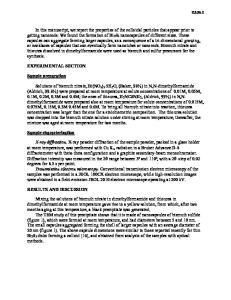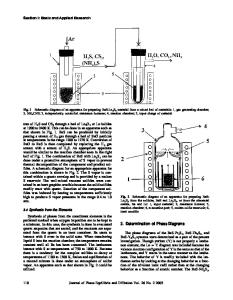Physical and Chemical Properties of Glass Composed of (Ga 2 S 3 ) 0.60 (La 2 S 3 ) 0.35 (Er 2 S 3 ) 0.05 and (Ga 2 S 3 )
- PDF / 1,054,208 Bytes
- 7 Pages / 612 x 792 pts (letter) Page_size
- 25 Downloads / 483 Views
ysical and Chemical Properties of Glass Composed of (Ga2S3)0.60(La2S3)0.35(Er2S3)0.05 and (Ga2S3)0.60(La2S3)0.27(Er2S3)0.13 A. S. Abdullaevaa, I. B. Bakhtiyarlya, *, and R. D. Kurbanovaa aNagiev
Institute of Catalysis and Inorganic Chemistry, National Academy of Sciences of Azerbaijan, Baku, Az1143 Azerbaijan *e-mail: [email protected] Received July 18, 2019; revised March 18, 2020; accepted April 3, 2020
Abstract—Glass composed of (Ga2S3)0.60(La2S3)0.35(Er2S3)0.05 and (Ga2S3)0.60(La2S3)0.27(Er2S3)0.13 is synthesized. It is found that glass composed of (Ga2S3)0.60(La2S3)0.35(Er2S3)0.05 softens during its thermal decomposition of in air at 855 K. In the range 945–1210 K, an exothermic effect is observed. The nature of the thermal curves indicates the stage mechanism of glass decomposition. IT is revealed that the absorption bands of glass typical for Me–S bonds are more intense and partially shifted toward the high-frequency spectrum than those for the initial crystalline components, which is apparently related to the increase in the covalence of the Ga–S and Ln–S bonds. Keywords: glass, thermal decomposition, endo-effects, exo-effects, physicochemical properties DOI: 10.1134/S1087659620040021
INTRODUCTION Chalcogenide glass is a promising material for infrared optics and semiconductor technology. It is ideal material for the development of optical lasers and amplifiers of remote sensors, high-speed switches, and other devices operating in the infrared wavelength range of 1 to 10 μm [1–5]. It is also used in devices for recording and storing optical holographic information in integrated optics as microinterferometers, switches, and nonlinear optical elements of photoresistors in microelectronics. Glass based on complex lanthanide sulfides with mixed cations (Nd3+, But3+, Er3+, etc.) is widely used in the creation of new optical and laser materials with special properties [6–9]. It is well known that for an individual compound of Ga2S3 the formation of glass is not characteristic. However, under certain tempering conditions, Ga2S3 with sulfides of various metals [10–14], including Ln2S3, Ln2O2S, and Ln2S3, forms glass in a wide range of concentration ratios of the starting components [15–24]. In [25] and in our studies, it was shown that, in comparison with other lanthanides, La3+ is most prone to glass formation. Our previous studies showed that in the quasi-triple La2S3–Ga2S3–Er2S3 system there is glass formation in a limited area along the Ga2S3–La2S3 side (Fig. 1) [26].
In [27], the luminescent properties were studied in the near IR and visible regions of some compositions from the glass-forming region shown in Fig. 1. As can be seen from Fig. 1, under these conditions, Er2S3 with Ga2S3 does not directly form glass. At the same time, glass composed of (Ga2S3)0.50(Er2S3)0.50 was formed in the work [25] at 1475 K. To establish new areas for the application of chalcogenide glassy semiconductor glass and to obtain glass with new functional properties, we consider it necessary to continue our previous research i
Data Loading...











